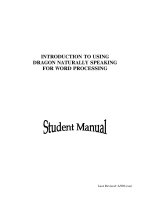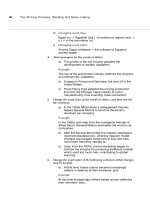Tài liệu Responsibility Charting: A Tool for Clarifying Roles docx
Bạn đang xem bản rút gọn của tài liệu. Xem và tải ngay bản đầy đủ của tài liệu tại đây (23.23 KB, 1 trang )
Responsibility Charting: A Tool for Clarifying Roles
Responsibility charting clarifies what is required to manage activities or decisions. It helps reduce
ambiguity, wasted energy, and adverse emotional reactions between individuals or teams who
work interdependently.
THE BASIC PROCESS
People whose roles interrelate or who manage interdependent groups list the activities or
decisions that affect their relationship on the vertical axis of a responsibility chart. Then they
identify the people involved in each action or decision and list them on the horizontal axis. The
people involved can include:
• the individuals directly involved in a decision
• the managers of those involved
• any people outside the organization who are customers of the decisions or activities
The participants then chart the required behavior of each person relative to a particular activity or
decision, using these classifications:
R - has
responsibility for a particular action, but not necessarily authority. This person or group
does not necessarily make the decision, but is responsible for making sure it is approved.
A - must approve - has power to veto the action
S - must
support - has to provide resources for the action (but not necessarily agree with it)
I - must be
informed or consulted before the action, but cannot veto
- irrelevant to the particular action
GROUND RULES
1. No box may contain more than one letter.
2. No more than one R can exist for an activity or decision. Agreement on where the R resides is the
first step. If agreement can't be reached on who has the R, there are three options:
− Break the problem into parts.
− Move the R up one level in the organization.
− Move the decision about the location of the R up one level.
3. Once the R is placed, other letters can be agreed upon.
4. Avoid deciding too many A's it leads to difficulty in making a decision or accomplishing the
task. Re negotiate to change some A's into S's or I's.
5. If one person has the A on most decisions, that person could become an obstacle to getting things
done.
6. The Support person has to expend resources or produce something that is then used by the person
Responsible for the action. The support role and its specific demands must be clarified and
clearly assigned.
The usefulness of responsibility charting lies not only in the end product of an agreed-upon
chart but also in the new understanding of people's roles and required behavior that grows out
of the charting process.









